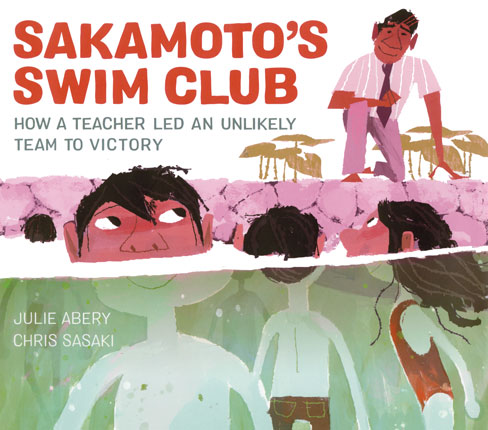| Sakamoto's swim club : how a teacher led an unlikely team to victory Author: Abery, Julie | ||
| Price: $22.58 | ||
Summary:
When the children of workers on a 1930s Maui sugar plantation were chased away from playing in the nearby irrigation ditches, local science teacher Soichi Sakamoto had an idea. He offered to take responsibility for the children-and then he began training them how to swim.
| Illustrator: | Sasaki, Chris |
| Accelerated Reader Information: Interest Level: LG Reading Level: 2.20 Points: .5 Quiz: 511924 |
Reviews:
Kirkus Reviews (05/01/21)
School Library Journal (05/01/21)
Booklist (+) (03/01/21)
The Hornbook (09/01/21)
Full Text Reviews:
Booklist - 03/01/2021 *Starred Review* In the 1930s on the Hawaiian island of Maui, the sugar plantation workers’ children were not allowed to swim in its irrigation ditches, but that didn’t stop them from trying. After watching young people repeatedly running from the plantation policeman on horseback, Soichi Sakamoto, a Japanese American science teacher, persuaded the company to let him take responsibility for the kids. He became their swimming coach. Growing stronger and faster day by day, they responded enthusiastically to Mr. Sakamoto’s innovative training program and high standards. Their team won the 1939 national championship. Because of WWII, the Olympics were cancelled in 1940 and 1944, but at the 1948 Olympic Games, a member of Sakamoto’s swim club won two gold medals. It’s a heartening story, concisely told in terse verse, with stanzas such as “Run! / Policeman’s on his beat. / Children scatter / in the heat.” The rhythm drives the momentum of the story, which unfolds over many years but reads very quickly. The informative, appended author’s note will be handy for answering children’s questions. Rugged, energetic, and purposeful, the digital artwork uses perspective to offer different viewpoints, sometimes putting viewers right down in the irrigation ditch or pool with the swimmers. A vibrant, original picture book. - Copyright 2021 Booklist.
School Library Journal - 05/01/2021 K-Gr 3—This short, brightly illustrated picture book tells the story of Japanese Hawaiian swim coach Soichi Sakamoto and his swim club's journey to the 1948 London Olympics. After a brief preface, the story opens with children swimming in the irrigation ditches of the sugar plantations in Maui, and Sakamoto offering to coach them, despite being a poor swimmer himself. In a series of iambic quatrains on each page, Abery tells the story sparely with a consistent rhyme that makes it sound and feel like a gentle bedtime story. Sasaki's upbeat and colorful digital illustrations show the action depicted by the words while adding to the story's joyful tone with lush depictions of Maui. For most of the book, this structure works, but it stumbles slightly when covering World War II. An illustration of smoke billowing from ships at sea accompanies the text, "Olympic hopes—/ crushed by war." The following illustration of an empty pool accompanies the lines, "Dawn raids shatter/ peaceful skies./ Athletes answer/ country's cries." Though cleverly rendered, this darker side of the story leaves out context that adults will need to provide for younger readers. An author's note follows the story, featuring a group photo and more detailed information. A brief list of resources concludes the book. VERDICT Despite its brevity, this book is sure to appeal to young readers and is a great contribution to sports history as well as Hawaiian history. A good addition to most children's nonfiction collections.—Erica Ruscio, Ventress Memorial Lib., Marshfield, MA - Copyright 2021 Publishers Weekly, Library Journal and/or School Library Journal used with permission.



